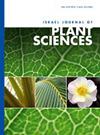Modulation of physiological responses and tolerance of Alternanthera tenella Colla (Amaranthaceae) to cadmium during in vitro cultivation
IF 0.9
4区 生物学
Q4 PLANT SCIENCES
引用次数: 1
Abstract
The use of plants that present clear physiological responses to heavy metals such as cadmium (Cd) can assist in environmental monitoring. The aim was to evaluate physiological responses of Cd in Alternanthera tenella plants in micro-controlled conditions and to assess the its tolerance level and bioindicator potential. Nodal segments of A. tenella were grown in flasks containing semi-solid MS medium supplemented with (0, 50, 100, and 150 μM Cd). The total fresh and dry weight of the plants, in addition to physiological analyses, were determined after 30 days of cultivation. Plants submitted to Cd showed a reduction in biomass and photosynthetic pigments content. The decline in the Chl a/b ratio indicated the deleterious effects of Cd, as evidenced by the decrease in the density of active reaction centers (RC/CSM). The levels of deterioration in the functionality or structural integrity of the thylakoid membranes (WL) and the activity of the oxygen evolution complex (WK) increased as a function of Cd concentrations. The decreases in photochemical and non-photochemical quenching (qP and qN, respectively) observed in plants exposed to Cd indicated photochemical dysfunctions. Additionally, the increase in the quantum yield of non-regulated energy dissipation (ΦNO) indicated the presence of photodamage. Plants had a low/intermediate TI level (≥21.7) in the analyzed concentration range. A. tenella plants can bioaccumulate high amounts of Cd. The level of physiological responses of A. tenella is dependent on the concentration of Cd, which makes the use of this species even more promising as a bioindicator for this metal.紫花苋(amaranaceae)对镉的生理反应和耐受性调控
利用对重金属(如镉)有明确生理反应的植物有助于环境监测。目的是评价微控制条件下柔嫩交替花植株对Cd的生理反应,评价其耐Cd水平和生物指标潜力。在含有添加(0、50、100和150 μM Cd)的半固体MS培养基的烧瓶中培养柔顺芽孢杆菌的节段。培养30天后测定植株的总鲜重和总干重,并进行生理分析。Cd处理的植株生物量和光合色素含量下降。Chl a/b比值的下降表明Cd的有害作用,活性反应中心(RC/CSM)密度的下降证明了这一点。类囊体膜(WL)功能或结构完整性的退化程度以及析氧复合物(WK)的活性随Cd浓度的增加而增加。Cd胁迫下植物光化学猝灭和非光化学猝灭(qP和qN)的减少表明光化学功能失调。此外,非调节能量耗散量子产率的增加(ΦNO)表明存在光损伤。在分析的浓度范围内,植物TI含量为中低水平(≥21.7)。tenella植物可以生物积累大量的Cd。tenella的生理反应水平取决于Cd的浓度,这使得该物种更有希望作为这种金属的生物指示物。
本文章由计算机程序翻译,如有差异,请以英文原文为准。
求助全文
约1分钟内获得全文
求助全文
来源期刊

Israel Journal of Plant Sciences
生物-植物科学
CiteScore
1.90
自引率
0.00%
发文量
17
审稿时长
>12 weeks
期刊介绍:
The Israel Journal of Plant Sciences is an international journal of extensive scope that publishes special issues dealing with all aspects of plant sciences, including but not limited to: physiology, cell biology, development, botany, genetic
 求助内容:
求助内容: 应助结果提醒方式:
应助结果提醒方式:


